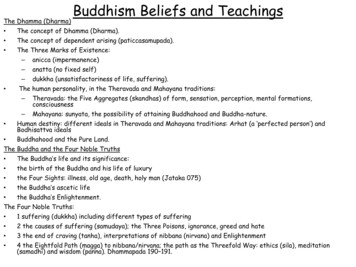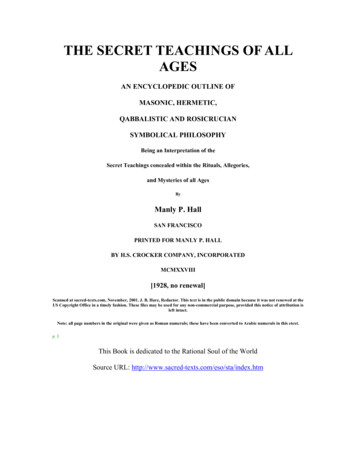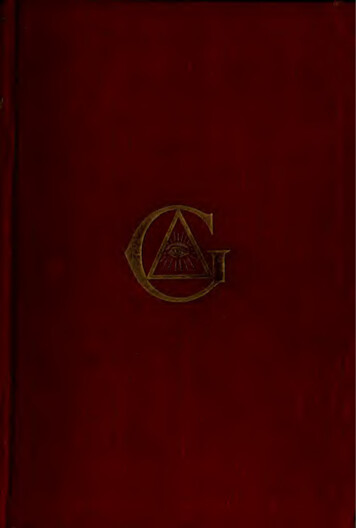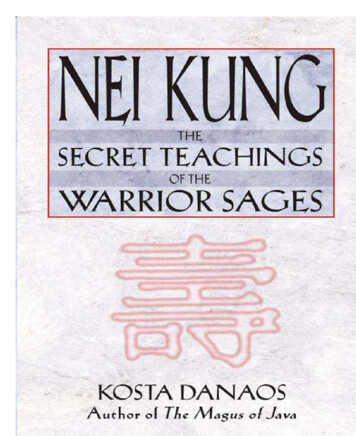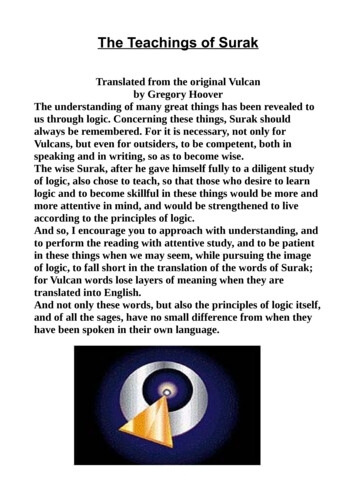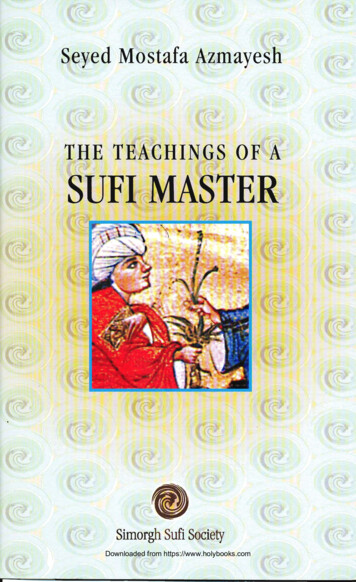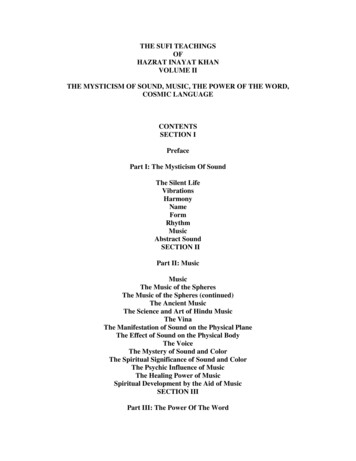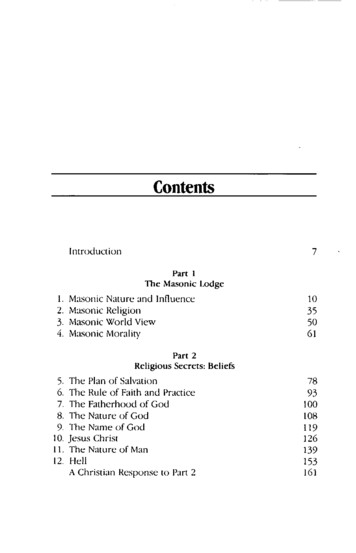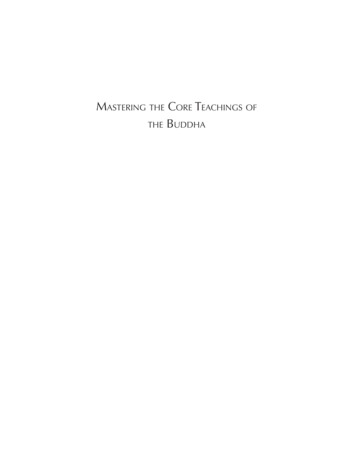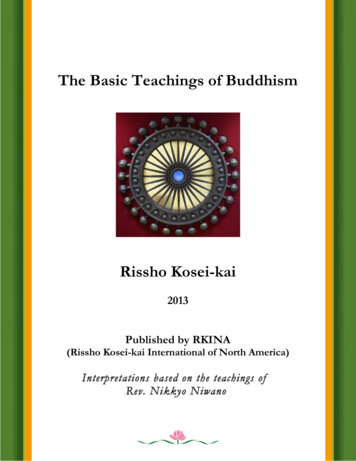
Transcription
The Basic Teachings of BuddhismRissho Kosei-kai2013Published by RKINA(Rissho Kosei-kai International of North America)Interpretations based on the teachings ofRev. Nikkyo Niwano
This text was edited by the staff of RKINA (Rissho Koseikai of North America), based on the translation of “Bukkyono Konpongi (Basic Teachings of Buddhism)”, which isextracted from “Buddhism for Today – a ModernInterpretation of the Threefold Lotus Sutra ” (KoseiPublishing Co.) written by Rev. Nikkyo Niwano in 1976.Second edition, 2013Published by Rissho Kosei-kai International of North America4255 Campus Drive, Suite A245, Irvine, CA 92612 USAAll rights reserved.2
Table of Contents1. Taking Refuge in the Three Treasures . 42. The Law of Causation . 63. The Seal of the Three Laws and the Four Laws . 74. The Four Noble Truths . 95. The Ten Suchnesses . 116. The Twelve Link Chain of Causation . 157. The Eightfold Path . 208. The Six Perfections. 239. Transmigration and Karma . 2610. The Three Thousand Realms in One Mind. 303
1. Taking Refuge in the Three TreasuresThe Precious Three are the basic elements that Shakyamuni Buddha taught hisdisciples as the spiritual foundation of Buddhism soon after he began hismissionary work: the Buddha, the Dharma, and the Sangha. Because of theirsupreme value, they are also called the Three Treasures.Before dying, the Buddha said, "Make the self your light, make the Dharma yourlight." These are words Shakyamuni spoke to Ananda, one of his ten greatdisciples. Ananda became anxious about the future and asked, "When the World honored One, who is an unparalleled leader and teacher, dies, who on earth canwe depend on in our practice and life?" In response to Ananda's anxiety, theBuddha said, "Ananda ! In the future, you should make yourself your light anddepend upon your own self. You must not depend upon other people. Youshould also make the Dharma your light and depend on the Dharma. You mustnot depend upon others.”This is the essence of a spiritual path. Buddha taught us that we could depend onourselves and walk the Way through our own efforts. He also taught us that bylearning the Dharma (Universal Truth as taught by the Buddha) we will be livingin the light. Thus, though we should live through our own efforts, we shouldalways live in accordance (harmony) with the Dharma.The Dharma is the Truth or Universal Law, whose true state is very hard forordinary people to grasp. Therefore, they feel insecure in building their mentalattitude upon it and basing actions in their daily lives on it. For this reasonShakyamuni Buddha explained the Dharma in terms of the following threeprinciples: the Buddha; the Dharma – the teachings of the Buddha ; and theSangha, whose meaning has been greatly misunderstood since ancient times.The Sangha has been interpreted as the community of Buddhist monks and nuns.But, in the case of the words, "I, with all the Sangha", the term indicates the ideaof believers in a broader sense. The Sanskrit word samgha means "an intimate andfaithful group consisting of many believers." Shakyamuni Buddha gave the nameSangha to the community of fellow believers who seek the same teachings as hisdisciples.4
People find it difficult to practice the Dharma (Buddha’s Teachings) in completeisolation. Most of us are apt to become lazy and lose the Path. But we cansteadily advance by sharing the teachings, helping each other with our awareness,and encouraging one another. This is the reason the Buddha regarded the Sanghaas one of our mental foundations.The things on which we can depend spiritually are the Three Treasures: theBuddha, the Dharma, and the Sangha. If we depend spiritually upon the Buddha,his teachings, and the community of believers, we can faithfully practice theDharma in our daily lives. Therefore Buddhists always take refuge in the ThreeTreasures.These words mean, “We depend on the Buddha, on the teaching of the UniversalTruth taught by him, and on the community which is closely unified for thepurpose of believing in and practicing these teachings, and we devote ourselvesto these Three Treasures.” Shakyamuni taught these three principles to hisbelievers to help them have faith and strength to practice with a positive attitude.This would help focus their devotion.5
2. The Law of Causation(Dependent Origination)Shakyamuni Buddha regarded this universe as the result of the relation betweencause and condition by which all phenomena are produced (dependentorigination). Causation means a cause and a condition combining to produce aneffect and recompense. In this physical world, there is nothing uncha ngeable orfixed in form.All things have a direct cause. When this comes into contact with a condition oropportunity, the result of this contact appears as a phenomenon or effect. Thiseffect leaves behind traces – recompense (impression). This is the wa yShakyamuni Buddha interpreted all things in the world.The combination of cause and condition leads every action to have an effect andrecompense. When a cause does not come into contact with a condition, orwhen a cause has been extinguished, it does n ot produce an effect andrecompense. Therefore, in this physical world there is nothing existing in aneternal, fixed, and unchangeable form.When we acknowledge that we are “cause” in our lives, not only are we never avictim, we are empowered to live in harmony with Universal Truth.Acknowledging our causal role in the encounters of our lives is not aboutassigning blame or shame. The very nature of being human is about encounteringlife. Whether the encounter results in a pleasant outcome or not, the importantissue is that the opportunity is something from which we learn. By placingourselves in the “cause” position, we are simply recognizing that we can onlycontrol our own choices and as we move through life the choices we make willdetermine our way forward. By acknowledging our primary role, we have theopportunity to create a positive approach to life by being aware of each mome nt,and making life choices that are a result of knowing the Dharma.6
3. The Seal of the Three Laws and the Four LawsThe core teachings of Buddhism are, “All things are impermanent”, “Nothinghas and ego”, and “Nirvana is quiescence.”(1) “All things are impermanent” (Everything is constantly changing)Modern science has proven that the sun, which seems to shine in the sky withoutchanging, is actually changing every moment. We think that there is no changebetween ourselves of yesterday and ourselves of today, but the fact is that thecells of the human body are constantly dying and being born, so that all the cellsof the body are replaced every seven years. Each cell of our body is changingcontinuously, though we are not aware of it. Everyone knows from experiencehow suffering, sorrow, joy or pleas ure can change in an instant. It would be anerror to think that things are consistent in this transient and unreliable existence.The Universal Law that "All things are impermanent", is the teaching by whichwe become aware of the changing nature of all t hings and therefore are not besurprised at, or shaken by changes in phenomena or circumstances.(2) “Nothing has an ego” (Non-self or Everything is interconnected)All things in this world, without exception, are related to one another. There isnothing that leads an isolated existence that is wholly separated from other things.When we consider that even tiny insects, birds flying high in the sky and pinetrees growing on a distant hill were part of the same matter at the beginning oftime on earth billions of years ago, we realize that these creatures are permeatedby the same life energy that gives us life. The same applies to earth, stone, cloudsand air. When we turn our attention to the present and consider our ownexistence, we know that if there w ere no clouds in the sky, we would have norain; if there was no rain, no plants would grow; if there were no plants, wewould have no food nor would the plants produce oxygen; and if there were noair, we could not live even for a few minutes. Without exc eption, we have someinvisible relationship even with those things that seem externally to have noconnection with us. Since most of the human body consists of water containingminerals, we live by the grace of salt, calcium, iron and copper. This factdemonstrates how things exist in connection with one another and areinterdependent. It goes without saying that we have a much closer and strongerrelationship to other human beings. We are inseparably bound with one anotherand we all exist permeated by the same life energy. In spite of this, opposition,dispute, struggle and killing cause each of us to be swayed by our ego, and to live7
selfishly for personal profit alone. This is the important reason why we mustrealize the truth of the teaching "Nothing ha s an ego ." (Everything isinterconnected)(3)Nirvana is quiescence (Transcending illusion will create tranquility)This is an ideal state of mind and body that completely extinguishes all thesufferings of human life and obtains peace, balance and harmon y. We cancompletely extinguish all the sufferings of human life and obtain peace andquietude when we destroy all illusions. How can we reach this state? The onlyway is to realize the two Universal Laws "All things are impermanent" and"Nothing has an ego." The reason we worry about various kinds of suffering isthat we forget that all phenomena in this world are impermanent, that all thingscontinuously change according to the Universal Law of “cause and effect”. Weare deluded by phenomena and influence d by considerations of immediate gainor loss. If we study the way to Buddhahood and by practicing it realize the Truthof the impermanence of all things, we become able to attain a state of peace andquietude in which we can never be swayed by shifting ci rcumstances. This is thestate of "Nirvana is quiescence." We sometimes feel troubled by setbacks inbusiness or personal conflicts. This is because we lack harmony with others andthe world around us. Why are we not in harmony? It is because we haveforgotten, or we do not realize the Truth that "Nothing has an ego"(Nothing hasa separate self). We can attain harmony with others spontaneously when weremember the Truth that all things and all people are permeated by one great lifeenergy, that all things are invisibly interconnected and when we make the bestuse of this interconnection by abandoning the idea of ego (separateness), itenhances the interconnection to benefit both ourselves and others. When inharmony with others, we can give up excess and deficiency, struggle and friction,and can maintain peaceful minds. This is the state expressed in the Universal Law"Nirvana is quiescence." (Transcending illusion will create tranquility)There is a Fourth Law: All will be suffering, if we do not remember that “AllThings are Impermanent” and “Nothing Has an Ego.” If the Truth is forgotten,suffering is the outcome. We can remember this at any time.8
4. The Four Noble TruthsTruth of Suffering, Truth of Caus e,Truth of Extinction, and Truth of the PathThe first of the Four Noble Truths is the Truth of Suffering. This means that allthings in this world cause suffering if we do not listen to or if we forget theBuddha's teachings. In other words, “Pain is inevitable, suffering is optional”. Toacknowledge the real condition of pain or suffering and see it through - withoutavoiding it or meeting it only halfway, is the Truth of Suffering.The Truth of Cause means that we must reflect on what causes and conditionshave led us to suffer, and then we can deeply investigate them to understandthem clearly. The investigation of the cause of suffering is shown in the doctrinesof: the “Reality of All Existence” (Ten Suchnesses) and the Twelve Link Chainof Causation. The original cause of all suffering is “ignorance” as seen in theTwelve Link Chain of Causation.The Truth of Extinction is the state of absolute quietude we experience whenour human sufferings have been extinguished. This state is attained when w eawaken to the three Universal Truths: "All things are impermanent", "Nothinghas an ego", and "Nirvana is quiescence". These three Truths, called the Seal ofthe Three Laws, are so important that they form the three fundamental principlesof Buddhism. When we recognize and let go of sufferings caused by physical,mental, or emotional attachments, we are then able to recognize this physicalworld as the Land of Eternally Tranquil Light (referred to in the Sutra ofMeditation of the Bodhisattva Universal W isdom as the land of the BuddhaVairocana).The Truth of the Path is that by practicing the teachings in our daily lives wewill realize these great Truths. We follow the Bodhisattva Way with our minds,words, and actions by practicing the Eightfold Path and the Six Perfections. TheTruth of the Path shows the way to a dynamic state of harmony and balance, ofabsolute peace and quietude, which is attained by practicing these teachings.The Law of the Four Noble Truths teaches us to acknowledge and face thereality of human pain and suffering, the Truth of Suffering; to grasp its realsource, the Truth of Cause; to know there is a way to extinguish suffering, the9
Truth of Extinction; to practice the Bodhisattva Path daily to remove thesuffering, the Truth of the Path.Truth of SufferingTruth of Cause(Buddha saw birth, sickness, old age and death)(Twelve Link Chain of Causation)st1 step is to acknowledge thesuffering, which can be- spiritual- physical- mental- economic- emotional2nd step is to investigate the specificand deep cause of suffering foundin the teachings of:Truth of ExtinctionTruth of the Path (end suffering)(Seal of the Three Laws)(Guidelines for action)rd3 step is knowing that there is atranquil state, without suffering,whether it be- spiritual- physical-mental-economic-emotional- The Ten Suchnesses(“Reality of All Existence”)- Twelve Link Chain of CausationMethod of practice forextinguishing suffering:- The Eightfold Path- The Six Perfections (Bodhisattva Way)(The Six Paramitas)The Buddha said:“One thing only do I teach: suffering and the cessation of suffering.”10
5. The Ten Suchnesses(Reality of All Existence)Such anAppearancePhenomenonSuch a NatureCharacterPerceived by six senses(five senses plus the mind)Personality and yet, inevery casesuch anultimateintegrationof them all(their equalitydespite theirdifferences)Such a SubstanceEmbodimentSuch a PotencyAbilitySuch a FunctionActivitySuch a CauseEmbodiedsubstances( choose this “position”when reflecting on situationsin your life)Such a ConditionEntityPotential EnergyEnergy in ActionInitial Thought, Word, ActionCircumstance orOccasionEnvironmental conditionsSuch an EffectResultOutcomeSuch a RecompenseImpressionIntangible ImpactThis teaching consists of ten words prefaced by "such a" or "such an" – "Such anAppearance," "Such a Nature," "Such a Substance," "Such a Potency," "Such aFunction," "Such a Cause," "Such a Condition," "Such an Effect," "Such aRecompense," and yet in every case, such an “ultimate integration of them all”.11
When we learn to view our world through this teaching, we begin to see thedeepest reality of the existence of all things in the universe. Another name forTen Suchnesses is "The Reality of All Existence".Modern science has analyzed physical substanc es to the extent of subatomicparticles. However, the “Principle of the Reality of All Existence” is even moreprofound because it extends to the mental world."Such an Appearance"The existence of all things invariably has a appearance, as perceived by the sixsenses (five senses plus the mind)."Such a Nature"That which has appearance, invariably has a nature (intangible qualities)."Such a Substance"That which has a nature, invariably has a substance."Such a Potency"That which has a substance invariably has potency (potential energy/power)."Such a Function"When it has potency, it invariably produces functions (energy in action)."Such a Cause"Innumerable embodied substances exist in the universe. For this reason, theiroutwardly-directed functions are interrelated with all things. Nothing in theuniverse has an isolated existence. All things have relation to each other sometimes a very complicated connection. Through this interdependence, theirinteraction causes various phenomena."Such a Condition"Even when a cause exists, it does not produce its effect until it comes intocontact with some occasion or condition. For instance, there is always vapor inthe air as the cause of frost or dew. But if it has no condition that brings it intocontact with the ground or the leaves of a plant, it does not become frost or dew.12
"Such an Effect"When a cause meets with a condition, this interaction produces a phenomenonor effect."Such a Recompense"An effect not only produces a phenomenon, but also invariably leaves some traceor impression. For example, the effect of frost forming will give a pleasantfeeling to someone who enjoys the patterns that it makes on the window panes,while the same effect will give an unpleasant feeling to some one whose cropshave been damaged by it. The function of an “effect” leaving a trace orimpression, is called "Such a Recompense."Another example of cause, condition, effect, and recompense could be seen in asimple action. Suppose you are waiting in a crowd of people and you notice thatthe person next to you has a very sad look on her face. After a while, without anydesire for reward or recognition, you make eye contact with this person and yousmile at her. She returns the smile and for that moment she is no longer sad. Shesees kindness in your face, and feels a connection once again to others. You alsofeel the connection and it refreshes your outlook.It will be helpful to explain cause, condition, effect, and recompense in moredetail. Suppose during a shopping trip, a cashier makes a mistake and gives youtoo much change. Upon discovering the error, you return the excess amountpointing out the error. This action has saved the cashier from a possiblereprimand and, possibly the loss of money, as they would have to make up theshortage in the receipts. Upon leaving the store you think, “I have donesomething good.” This is recompense. This recompense comes from one’smind and from outside. The former comes first to him, and it is the mostimportant recompense."Such an Ultimate Integration of them All” (equal to “emptiness” or “oneness”)The nine suchnesses mentioned above occur continuously in society, and in theuniverse as a whole. They are interconnected in a complex web, so that in mo stcases, we cannot discern what is a “cause” and what is an “effect.” But thesesuchnesses never fail to operate according to the Law of Universal Truth, and noone, nothing, and no function can depart from this Truth. Everything functionsaccording to this, from Appearance to Recompense - from beginning to end.This is the meaning of " and yet in every case, such an ultimate integration of13
them all.”Shakyamuni Buddha expounded this rule through the doctrine of the TwelveLink Chain of Causation (Dependent Origination) , meaning that all phenomena areproduced and extinguished by causation. This term indicates that a thing arisesfrom, or is produced, because of a condition. Nothing makes an appearanceunless there is an appropriate condition. This Tru th applies to all existence andphenomena in the universe. The Buddha intuitively perceived this so deeply thateven modern science has found nothing to contradict this teaching.When the conditions change, the substances produced change and create anotherappearance. When water comes into contact with a high temperature as acondition, it evaporates. When vapor comes into contact with cold air as acondition, it condenses and forms a cloud. Events and the function of the mindare similar. Everything follows this rule.Because this law explains how all things work - not only objects of the physicalworld, like human beings, but also ideas and issues of the mental world, such asour relationships with one another - it is called the "Principle of the Reality of AllExistence."Ultimate Integration of them AllAppearanceNatureSubstancePotencyFunctionCause ConditionEffectRecompenseAs you can easily recognize, this is a detailed analysis of the Universal Law ofCausation that you previously learne d. “Nature” is very important in thisteaching. It represents the heart and mind. We are a composite of first fivesuchnesses. When we interact with each other, our natures are a key element.14
6. The Twelve Link Chain of CausationThis law, also called the doctrine of the twelve link chain of dependentorigination, teaches that all phenomena in this world constantly change,appearing and disappearing, and that all changes are based on an established rule.Though all things change, this teaching is undeniable. It is known as the TwelveLink Chain of Causation because the teaching is divided into twelve stages.However, it is easier for us to understand this law by limiting it to people than bytrying to apply it to all phenomena at once.The Buddha taught the Law of the Twelve Causes in detail to Ananda in theDirghagama Sutra. This law governs the growth of the human body (outercausation), as well as the changes in one's mind (inner causation). “Outercausation” explains the process, through which a human being is born, grows,ages, and dies - in the light of the three temporal states of existence: the past,present and future. “Inner causation” shows how one's mind changes, and thefundamental method of purifying it and removing illusions.The twelve links or stages are (1) Ignorance, (2) Actions, (3) Consciousness, (4)Name and Form, (5) the Six Entrances (the five senses, and the mind), (6)Contact, (7) Sensation, (8) Desire, (9) Clinging, (10) Existence, (11) Birth, (12)Old Age and DeathOuter CausationFor the physical body, the first link of the Twelve Causes is ignorance. We areborn into this world as a continuation of a karmic cycle. We are conceivedthrough the action of intercourse (or the implantation of a fertilized egg). Thislife has no in formation to begin with, but at the moment of conception,consciousness begins to grow. Consciousness means, “something living” Heresomething like a human being (a fetus) is produced, although it is still incomplete.As the incomplete consciousness is gra dually taking shape, it grows into nameand form (mental functions and matter). "Name" means an immaterial being(spirit), and "form" indicates a material being, (human body). So, with "name andform" there is body and spirit.15
As name and form (mind and b ody) grow, they develop the Six Entrances.These are the five sense organs - eyes, ears, nose, tongue, body - and the part ofthe mind that relates these senses. At this time, we are still in the mother's womband incomplete. This stage is called the "Six Entrances" because the functions ofour minds and bodies are on the point of dividing into the six different senses.We are physically born into this world at the stage of the Six Entrances (at themoment of birth - body, mind, and spirit come together as one). When we growto the age of two or three, these entrances are completed and sensibility isdeveloped. That is, we become able to discern shapes, colors, sounds, smells,tastes, and physical sensations. This stage is called Contact.As sensibility is maturing, we develop likes and dislikes. This state is calledSensation. When such feelings appear, desire for things arises spontaneously.In this context, desire is physical (sexual) attraction. In other words, this is a stateof mind that has preferences and that clings to what it likes. When we have desirefor something, we try to hold on to it. Conversely, we try to avoid what weconsider unpleasant or undesirable. This is called Clinging. Clinging leads tovarious feelings, ideas, and assertions. This is Existence, or the possessive mind.It is during this stage that we usually get married or find a life partner, andperhaps have children. Due to this possessive mind, opposition and struggleoccur among people, and human life with its pain and suff ering begins. Thisstage is called Birth. Old Age comes before we know it, and finally oneencounters Death.In short, the Law of the Twelve Causes teaches that until we remove ignorance,we continue to be reborn in this cycle. The Law also teaches that if we eradicateour ignorance in the present world, and understand our true essence is not thephysical form - the essential form of our life as it was meant to be, will berevealed in our future life. Here we should not limit the meaning of "future life"to life when we are reborn after death, but should regard it rather as the lifebefore us from this moment forward. If we abandon this meaning of“ignorance” and set our minds in the direction of the Dharma, a bright andserene life will begin to unfold.Living in this type of ignorance, causes us to become self-centered, experiencingsuffering. The Japanese character for this ignorance means, “There is no light”16
Inner CausationThe Twelve Link Chain of Causation (Dependent Origination) also applies to thegrowth and changes in one’s mind. “ Ignorance” is failure to know UniversalTruth, or to disregard the Way even if we know it. It is the cause of all illusionand a failure to deeply understand basic Buddhist principles. This predisposition,is the cause of repeated actions which are contrary Universal harmony. Thisinvolves actions in the present as well as those of the past. Because of ignoranceof the Truth, one repeatedly behaves, speaks, and thinks contrary to the Truth.One action, thought, or word leads to another. These actions, thoughts, or wordsbegin to add up or accumulate. This is expressed by sayings such as, “You reapwhat you sow.” One action based on ignorance leads to another based onignorance, and so on. It is this accumulation o f actions, thoughts, and wordsover time which is the basic idea behind karma. If we act in ignorance, ouractions, thoughts, and words build up negatively. Through learning the UniversalTruth and acting in harmony with it, our actions, thoughts, and wo rds build upfor our benefit, as well as for the benefit of all beings. This is a simple way oflooking at karma.Consciousness is awareness and perception of what is happening around us eachmoment, moment by moment. That awareness is colored by our pa stexperiences (karma). As we act, think, and speak, our awareness and perceptionschange. If we continue in ignorance, our consciousness changes in ignorance. Ifwe learn and understand the Truth, our consciousness changes in beneficial ways.Our consciousness is always changing.Name and Form or immaterial being (spirit) and material being (body) refers tothe mental realities and perceptions we have of the world around us through oursensory organs – shapes, sounds, odors, tastes, and the feel of th ings throughtouch. These two together, refer to our existence (human being). It is thedevelopment of mind and body. It is through consciousness that we are able tohave a faint idea of our existence.The Six Entrances or are the functions of the sense organs. The six sense organsare the eye, the ear, the nose, the tongue, the body and the mind. The functionsof these organs are sight, hearing, smell, taste, touch and perception. This is avery important stage - affecting the future of the baby after it is born.17
Though we are aware of our own existence (name and form), throughconsciousness, it is still too vague to constitute an awareness to true knowledge.At the same time that the senses are developing, our mind by which we perceivethe existence of things through the other senses, matures. At this point we firstgain the power to discern things clearly. This is called Contact.Contact is the stage at which we are born and we discern, or see, the worldaround us.Sensation (perception) is the plea sure or pain we experience from mentaldevelopment and sensing the world around us. These feelings are colored by ourpast experiences.Feelings give rise to desires, which are spontaneous or impulsive and based onignorance. It is the state of mind in which we not only have preferences – wecling to them passionately.Clinging (attachment) is manifested by our reaching out to attain when we crave.This is called clinging and is often expressed in our thoughts, and throughphysical or verbal action. This continues the cycle of rebirth.Existence is seeing the duality, and is the evolution of the person’s intellect,temperament, and skills as influenced by and as a result of craving.Birth in this realm of inner causation is the realization of the ev olving self, theself influenced by past actions, thoughts, and words arising out of ignorance.These perpetual thought patterns create a karmic cycle.Old age and Death is the inevitable result or consequence of these precedingprocesses. It is sorrow, grief, and suffering which arise out of actions, thoughts,and words repeated out of ignorance.Ignorance in the context of Buddhism, creates repetition of the cycle of physicalbirth and death. We can break this cycle, by attaining Enlightenment andknowing Universal Truth. To ignore this teach
Buddha, the Dharma, and the Sangha. If we depend spiritually upon the Buddha, his teachings, and the community of believers, we can faithfully practice the Dharma in our daily lives. Therefore Buddhists always take refuge in the Three Treasures. These words mean, “We depend on the
